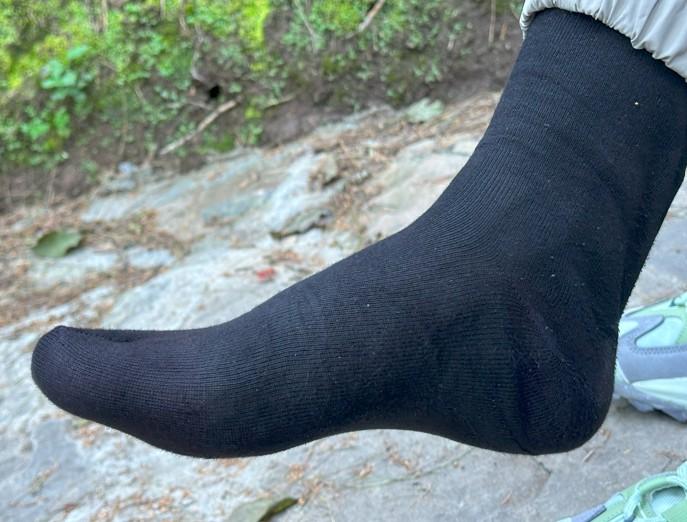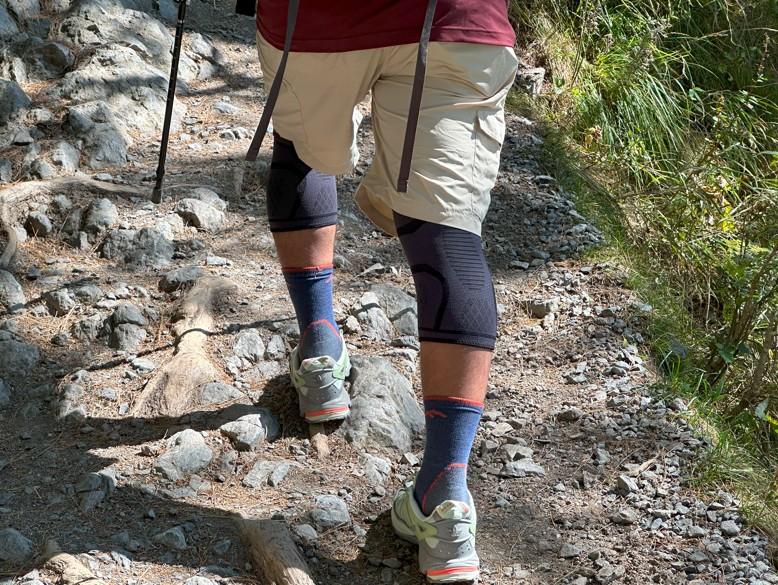Cotton is a popular and affordable material that people wear around the world. Cotton is not only breathable but also comfortable to wear. That’s why you’ll see a variety of clothes made from cotton, including sleepwear.
Related: Is Polyester Good for Hiking?
Then why is cotton terrible for hiking?. Its poor moisture management, slow drying time, and lack of insulation (when wet) make it a bad choice for hiking and other high-intensity activities, such as intense workouts, running, and sports in humid or rainy weather.
Reasons: Why Cotton is Bad for Hiking
Cotton Absorbs Moisture
Hiking is a high-intensity physical activity, which means you’ll sweat, except perhaps in cold weather. I sweat even during mild weather after two to three hours of continuous hiking, and some people sweat more than others.
Related: Best Material for Hiking Socks
Now, imagine your shirt is soaked with sweat, but it’s not drying. How would you feel? Of course, it’s uncomfortable, but chafing is the worst part.

The fabric rubs against your skin, causing friction, which can lead to stinging or burning sensations and the development of a mild, red rash or boils.
During rain, which is common in the mountains, cotton absorbs moisture, becoming damp and heavy.
Cotton Takes Time to Dry
The worst part of hiking is when your clothes become wet, either from rain or sweat. Why does cotton take time to dry? Because cotton is highly absorbent, and in areas with high humidity or low airflow, evaporation is slower, and as a result, the cotton fabric takes longer to dry.
I don’t want to stay wet for long on the trail, so I ditched cotton from my outdoor hiking clothes long ago, including underwear, socks, and pants.
If you plan to hike regularly or for extended periods, you’ll want to do the same. When backpacking, I can’t afford to wait for my clothes to dry before continuing.
Cotton is a Poor Insulator When Wet
That’s why you’ll notice most people wear cotton clothes in mild, dry conditions or as sleepwear. However, if you get wet in your clothes while hiking in chilly weather, you can catch a cold. As mentioned earlier, cotton absorbs moisture and takes time to dry, which negatively impacts its insulation.
Dry cotton fabric traps air within its fibers, which helps to provide insulation by slowing down the transfer of heat. But when it gets wet, the water fills the spaces between the fibers and displaces the air. As a result, damp cotton allows more heat to escape, reducing its ability to keep you warm on the trail.
Don’t wear cotton in winter, as the weather can get colder at night, and improper clothing can make you sick.
Alternatives to Cotton for Hiking
Synthetic Fabrics
Synthetic fabrics like polyester and nylon are commonly used in hiking clothes, pants, and socks. They are ideal for moisture-wicking, which is essential for outdoor adventures. Since these are hydrophobic materials, they repel water instead of absorbing sweat and moisture like cotton.

Moisture evaporates more easily since these fabrics draw moisture away from the skin toward the surface. Since they don’t retain moisture, they dry quickly, saving me time on the trail.
Most of my hiking shirts and socks are mainly made from polyester and nylon. It’s a bit expensive when you compare it with the cotton fabric. But they offer features like durability, moisture-wicking, and stretchability (great for freedom of movement on tough terrain).
Additionally, these materials are lightweight, which is essential for hikers. I noticed that they retain odor (but far less than cotton) after extensive use compared to my wool fabric socks and shirts.
Merino wool
Merino wool is an excellent choice for hiking due to its combination of key benefits, such as breathability, moisture-wicking, and warmth retention. It enhances comfort and hiking performance.
Merino wool is more expensive than polyester and nylon. It is blended with synthetic fabrics for better elasticity and durability. I take Merino wool socks and underwear, which save me from odor and washing them repeatedly on the trail. It saves me plenty of time, as you can wear the same socks for days without washing.

I take two pairs of socks for hiking. One is merino wool, and the second is polyester (with a high percentage of polyester material). I wear just the wool socks for days as they don’t stink for days, and I keep the second pair as a backup.
Until I feel the necessity to absolutely change the socks (which is rare on 5- to 7-day trips), I don’t go with my polyester pair. If I wear cotton socks in the morning and they feel so stinky by the end of the day, I’ll not want to wear them again the next morning.
Summary
Cotton is a popular and versatile fabric, but it’s unsuitable for hiking or intense physical activities. It absorbs moisture, takes time to dry, and lacks insulation when wet, making it a poor choice for the trail.
Cotton is fine for:
- Casual wear
- Summer dresses
- Everyday comfort
- Low-intensity activities
But when it comes to hiking, materials like polyester, nylon, and wool outperform cotton with their exceptional moisture management, quick drying and durability. I have socks, underwear, and other clothes made from wool and synthetic fabrics for hiking and running.
In short, cotton is unsuitable for hiking, especially in:
- Cold Weather
- Wet
- Humid conditions
- Intense activities
- When you need durability
- When you want moisture-wicking clothing.
Related Article:
